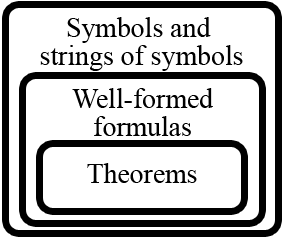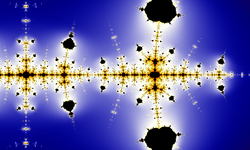This article is about aspects of the concept of a theorem that are not limited to its strictly mathematical use. For mathematical theorems see Theorem

A theorem is an idea, concept or abstraction token instances of which are formed using a string of symbols according to both the syntactic rules of a language (also called its grammar) and the transformation rules of a formal system. Specifically, a theorem is always the last formula of a derivation in some formal system each formula of which is a logical consequence of the formulas which came before it in the derivation. The initially accepted formulas in the derivation are called its axioms, and are the basis on which the theorem is derived. A set of theorems is called a theory.
What makes theorems useful and of interest is that they can be interpreted as true propositions and their derivations may be interpreted as a proof of the truth of the resulting expression. Very often, in mathematical logic a theorem is expressed in a formal language, in which case it may be called a formal theorem. The syntactic rules of the formal language may be called its formal grammar or formation rules. A set of formal theorems may be referred to as a formal theory. A theorem whose interpretation is a true statement about a formal system is called a metatheorem.
The concept of a theorem is fundamentally syntactic, in contrast to the notion of a "true proposition" in which semantics are introduced. Different deductive systems may be constructed so as to yield other interpretations, depending on the presumptions of the derivation rules (i.e. belief, justification or other modalities). The soundness of a formal system depends on whether or not all of its theorems are also tautologies. A tautology is a formula that is true under any possible interpretation. A formal system is considered semantically complete when all of its tautologies are also theorems.
Syntax and semantics
Derivation of a theorem
The notion of a theorem is deeply intertwined with its derivation. Given a particular very simple formal system (we shall call ours ) whose alphabet α consists only of two symbols { , } and whose formation rule for formulas is:
- 'Any string of symbols of which is at least 3 symbols long, and which is not infinitely long, is a formula of . Nothing else is a formula of .'
The single axiom of is:
- ' '
The transformation rule for is:
- 'Any occurrence of '' in a formula of may be replaced by an occurance of the string ' ' and the result is a formula (wff) of .'
Theorems in are defined as those formulae in of which a derivation can be constructed, the last line of which is that formula.
- 1) (Given as axiom)
- 2) (by applying the transformation rule)
- 3) (by applying the transformation rule)
Therefore ' ' is a theorem of . The string ' ' is not considered to be "true" or "proved," until it is given an interpretation it is merely derived.
Two metatheorems of are:
- 'Every theorem of begins with ''
- 'Every theorem of has exactly two triangles.'
Interpretation of a theorem
A derivation of a theorem can be interpreted as a proof of the truth of some proposition. To establish a proposition as a theorem, the existence of a line of reasoning from axioms in the system (and other, already established theorems) to the given statement must be demonstrated.
Although the proof is necessary to produce a theorem, it is not usually considered part of the theorem. And even though more than one proof may be known for a single theorem, only one proof is required to establish the theorem's validity. The Pythagorean theorem and the law of quadratic reciprocity are contenders for the title of theorem with the greatest number of distinct proofs.
The definition of theorems as elements of a formal language allows for results in proof theory that study the structure of formal proofs and the structure of provable formulas. The most famous result is Gödel's incompleteness theorem; by representing theorems about basic number theory as expressions in a formal language, and then representing this language within number theory itself, Gödel constructed examples of statements that are neither provable nor disprovable from axiomatizations of number theory.
Example
Given a different simple formal system (we shall call this one ) whose alphabet α consists only of three symbols { , , } and whose formation rule for formulas is:
- 'Any string of symbols of which is at least 6 symbols long, and which is not infinitely long, is a formula of . Nothing else is a formula of .'
The single axiom schema of is:
- " * * " (where " * " is a metasyntactic variable standing for a finite string of " "s )
A formal proof can be constructed as follows:
- (1)
- (2)
- (3)
In this example the theorem produced " " can be interpreted as meaning "One plus three equals four." A different interpretation would be to read it backwards as "Four minus three equals one."
Relation to theories
A theory is a collection of theorems. The main broad distinction to be made among different types of theories is whether or not their theorems are intended to be interpreted as representing a true proposition which is empirical or non-empirical. If every theorem of a theory is empirical, then it is a scientific theory (also called an empirical theory). If there is even one non-empirical theorem in the theory, it is a non-empirical theory.
Theorems in mathematics and logic are non-empirical because they have no content until given an interpretation. This is precisely why theorems of mathematics and logic are useful. They can be applied to any subject matter no matter what its content. If the content of a theory consists entirely of theorems whose interpretations are statements about observation and sense data, than it is a scientific theory.
It is not correct to say that a scientific theory is either true or false as its theorems may be. A theory is taken as a whole as strongly or weakly supported by the facts. A key attribute of a scientific theory is that it is falsifiable, that is, it makes predictions about the natural world that are testable by experiments. Any disagreement between prediction and experiment demonstrates the incorrectness of the scientific theory, or at least limits its accuracy or domain of validity. Mathematical theorems, on the other hand, are purely abstract formal statements: the proof of a theorem cannot involve experiments or other empirical evidence in the same way such evidence is used to support scientific theories.

Nonetheless, there is some degree of empiricism and data collection involved in the discovery of mathematical theorems. By establishing a pattern, sometimes with the use of a powerful computer, mathematicians may have an idea of what to prove, and in some cases even a plan for how to set about doing the proof. For example, the Collatz conjecture has been verified for start values up to about 2.88 × 1018. The Riemann hypothesis has been verified for the first 10 trillion zeroes of the zeta function. Neither of these statements is considered to be proven.
Such evidence does not constitute proof. For example, the Mertens conjecture is a statement about natural numbers that is now known to be false, but no explicit counterexample (i.e., a natural number n for which the Mertens function M(n) equals or exceeds the square root of n) is known: all numbers less than 1014 have the Mertens property, and the smallest number which does not have this property is only known to be less than the exponential of 1.59 × 1040, which is approximately 10 to the power 4.3 × 1039. Since the number of particles in the universe is generally considered to be less than 10 to the power 100 (a googol), there is no hope to find an explicit counterexample by exhaustive search at present.
Note that the word "theory" also exists in mathematics, to denote a body of mathematical axioms, definitions and theorems, as in, for example, group theory. There are also "theorems" in science, particularly physics, and in engineering, but they often have statements and proofs in which physical assumptions and intuition play an important role; the physical axioms on which such "theorems" are based are themselves falsifiable.
See also
Notes
- ^ Godel, Escher, Bach: An Eternal Golden Braid, Douglas Hofstadter
References
- Hoffman, P. (1998). The Man Who Loved Only Numbers: The Story of Paul Erdős and the Search for Mathematical Truth. Hyperion, New York.
- Petkovsek, Marko; Wilf, Herbert; Zeilberger, Doron (1996). "A = B". A.K. Peters, Wellesley, Massachusetts.
((cite book)): External link in|title=
| Major fields |
| ||||
|---|---|---|---|---|---|
| Foundations | |||||
| Lists |
| ||||






